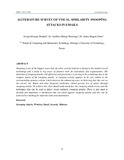A Literature Survey of Visual Similarity Snooping Attacks in Emails
| dc.contributor.author | Muhindi, George M. | |
| dc.contributor.author | Wambugu, Geoffrey M | |
| dc.contributor.author | Oirere, Aaron M. | |
| dc.date.accessioned | 2020-09-18T17:25:44Z | |
| dc.date.available | 2020-09-18T17:25:44Z | |
| dc.date.issued | 2020-08 | |
| dc.identifier.citation | International Journal of Scientific Research and Innovative Technology Vol. 7 No. 7; August 2020 | en_US |
| dc.identifier.issn | 2313-3759 | |
| dc.identifier.uri | http://hdl.handle.net/123456789/4440 | |
| dc.description.abstract | Snooping is one of the biggest issues that the cyber security industry is facing in this modern era of technology and it leads to big losses of finances both for individuals and organizations. The detection of snooping attacks with efficiency and preciseness is proving to be a challenge due to the complex nature of the snooping attacks. A snooping website appears to be very similar to the corresponding genuine website which deceives the unknowing users to believing that they are on the correct site. Banks and other financial institutions should prevent loss of money through snooping attacks. To achieve this, they should understand how the snooping attacks occur and the techniques that can be used to detect visual similarity snooping attacks. There is also need to develop and implement a mechanism that can check against snooping attacks and this can be achieved by checking for malicious links and attachments. | en_US |
| dc.language.iso | en | en_US |
| dc.subject | Snooping Attacks | en_US |
| dc.subject | Websites | en_US |
| dc.subject | en_US | |
| dc.subject | Security | en_US |
| dc.subject | Malware | en_US |
| dc.title | A Literature Survey of Visual Similarity Snooping Attacks in Emails | en_US |
| dc.type | Article | en_US |
Files in this item
This item appears in the following Collection(s)
-
Journal Articles (CI) [141]

